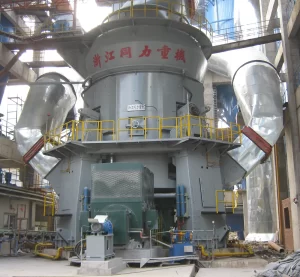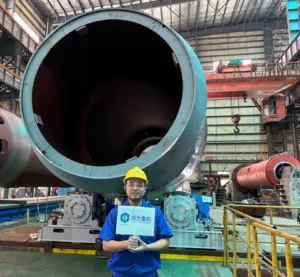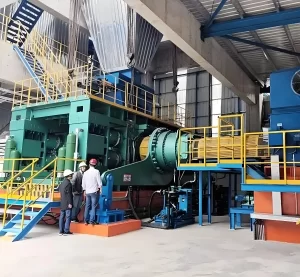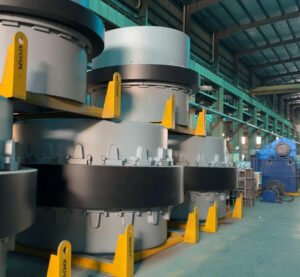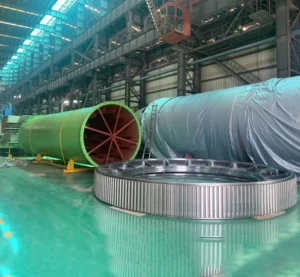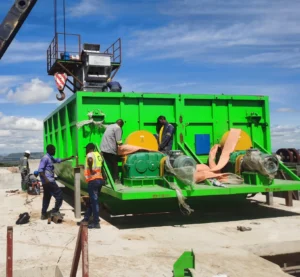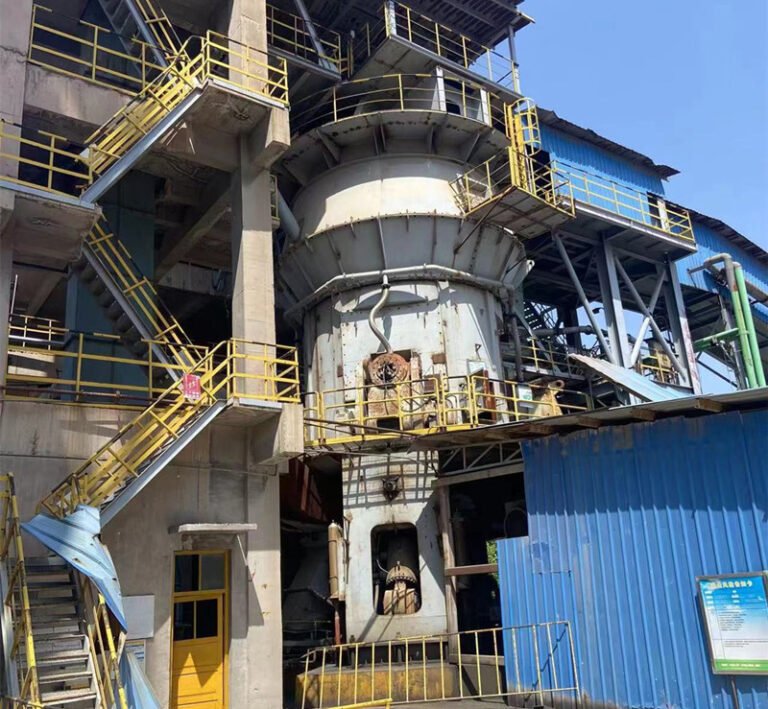
Clinker is the spherical material produced during the kiln stage of the cement production process and used as a binder for many cement products. Clinker lumps or spheres are typically 3-25 mm in diameter and dark grey in colour. Clinker is produced by heating limestone and clay to liquidus temperature (approximately 1400°C-1500°C) in a rotary kiln. Cement is made by grinding the clinker together with gypsum (which controls the setting characteristics of cement and ensures compressive strength)using vertical roller mill or ball mill or roller press. Clinker can be stored for long periods of time under dry conditions without deterioration in quality and is the main raw material for cement, also known as a semi-finished product. The mineral structure of the clinker affects the grinding energy of the clinker and determines the properties of the cement by changing parameters such as strength and setting time.
Composition of clinker

The composition of clinker can be checked in two different ways:
- Mineralogical analysis, using a rock microscope and/or X-ray diffraction analysis
- Chemical analysis, the most accurate method is by X-ray fluorescence spectroscopy
The four main components of clinker are:
- Alite: Approximately tricalcium silicate (usually around 65% of the total)
- Dicalcium silicate: Approximately dicalcium silicate (usually around 15% of the total)
- Aluminate: Very close to tricalcium aluminate (usually around 7% of the total)
- Ferrite: Very close to tetracalcium aluminum ferrite (usually around 8% of the total)
Other substances may be present in small quantities:
Salt phase – various combinations of sodium, potassium and calcium cations with sulfate and chloride ions, e.g.
- Aphthitalite - K2SO4
- Aphthitalite - K 2 Ca 2 (SO 4 ) 3
- Aphthitalite - K 3 Na(SO 4 ) 2
- Potassium salt - KCl
Low temperature phases – various intermediate chemicals that have not undergone further heat treatment, e.g.
- Sulphite - Ca 5 (SiO 4 ) 2 (CO 3 )
- Pyrocatecholite - Ca 5 (SiO 4 ) 2 (SO 4 )
- Sinkerite - Ca 10 (SiO 4 ) 3 (SO 4 ) 3 (OH) 2
- Phyllostachite - Ca 4 (AlO 2 ) 6 (SO 4 )
The chemical analysis of clinker is usually given in terms of oxides as follows (in wt. % oxides):
| Silica Dioxide | Aluminum Oxide | Iron Oxide | Calcium Oxide | Magnesium Oxide | Potassium Oxide | Sodium Oxide | Sulfur Trioxide | Letter of Intent | Infrared | Total |
| 21.5 | 5.2 | 2.8 | 66.6 | 1 | 0.6 | 0.2 | 1 | 1.5 | 0.5 | 98.9 |
Free lime = 1.0% CaO
The balance is made by adding alkaline sulphates and small amounts of impurities such as small amounts of oxides of titanium, manganese, phosphorus and chromium.
The contents of the different components vary depending on the desired characteristics of the clinker produced.
Thermochemistry of clinker
The raw materials entering the kiln are taken out at room temperature. The temperature in the kiln continues to rise, reaches a peak, and then cools rapidly to produce clinker. Although the reaction stages often overlap, they can be represented in the following clear sequence:
- 65-125°C: Free water evaporates: latent heat needs to be replenished. Net heat input: 2145 kJ/kg clinker.
- 400-650°C: Clay decomposes endothermically, and alkali metals react with the kiln atmosphere to form liquid sulfates. Net heat input: 42.2 kJ/kg clinker.
- 500-650°C: Dolomite decomposes endothermically. Net energy input: 19.7 kJ.
- 650-900°C: Calcium carbonate reacts endothermically with silicon dioxide to form "initial belite". Net heat input: 722.5 kJ
- 700-900°C: Calcium carbonate reacts endothermically with aluminum oxide and iron oxide to form initial aluminates and ferrites. Net heat input: 207.2 kJ.
- 900-1050°C: When all available silica, alumina and iron oxide have reacted, the remaining calcium carbonate decomposes endothermically to calcium oxide. Required heat input: 601.9 kJ/kg clinker.
- 1300-1425℃: Aluminates, ferrites and some belites melt endothermically, and belites react with calcium oxide to form aluminates.
- 1425-1300°C: After exceeding the peak temperature, the melt exothermically refreezes into aluminates, ferrites and belites.
Types of clinker

There are 5 main types of clinker. Here is a brief overview of them:
Sulfate-resistant clinker
The composition of this clinker is: aluminosilicate 76%, belite 5%, tricalcium aluminate 2%, tetracalcium aluminoferrate 16% and free calcium oxide 1%. In recent years, the production of this clinker has declined, as sulfate resistance can now be achieved by using granulated blast furnace slag in cement production.
Low-heat clinker
This clinker consists of 29% alite, 54% belite, 2% tricalcium aluminate and 15% tetracalcium aluminoferrate. It contains very little free lime. Low-heat clinker is no longer produced. This is because the same low-heat properties can be obtained with ordinary clinker and crushed granulated blast furnace slag.
White clinker
The composition of white clinker includes: 76% alite, 15% belite, 7% tricalcium aluminate (without tetracalcium aluminoferrate, which would reduce the whiteness), and 2% free lime. White clinker is used to make white cement, which in turn is used for artistic and aesthetic purposes. Typically, a large portion of white cement is used in precast concrete.
Low alkali clinker
There are two ways to reduce the alkali content in clinker. They are as follows:
- Replace the alumina supply with alternative raw materials. In this way, you get a product from a distant origin with a higher price.
- Another method is to install or add an "alkali exhaust device". The purpose of this device is to exhaust some of the high-temperature gases in the kiln because the flue gas produced by these gases contains alkali. The disadvantage of installing an alkali exhaust device is that it will cause heat waste.
Belite Calcium Sulphoaluminate Clinker (BCT)
Today, everyone is actively fulfilling their environmental responsibilities. Cement manufacturers have also joined this trend. BCT is a clinker that can reduce carbon dioxide emissions by 30%. Its production process is also more energy-efficient because the power consumption during the production process is reduced by about 15%. Therefore, it can be said that BCT is a green clinker.
Use of clinker - used to make cement
Clinker is mixed with some additives and crushed into a fine powder which is used as a binder for many cement products. Depending on the desired properties of cement, different materials are added. However, one core substance that is always added is “gypsum” as it avoids instant setting of tricalcium aluminate. Gypsum not only regulates the setting time of cement but also imparts compressive strength to it. Triethanolamine, ethylene glycol, oleic acid and dodecylbenzene sulfonate are some of the additives used in clinker. It is also combined with other active ingredients or materials to produce different types of cements such as:
- CEM I: Pure Portland clinker (Ordinary Portland Cement, OPC).
- CEM II: Blended cement with small amounts of blast furnace slag (BFS) or limestone filler.
- CEM III: BFS-OPC blast furnace cement.
- CEM IV: Pozzolanic cement.
- CEM V: Composite cement (containing large amounts of BFS, fly ash or silica fume).
- The above CEM nomenclature complies with the European EN 197-1 standard.
The main use of clinker is in the production of cement. Since clinker is a hard, spherical substance, it can be stored for months in dry conditions. Due to its shape and size, clinker is easy to handle, which is one of the biggest reasons why it is traded in large quantities internationally. In places where the raw material for cement is scarce or scarce, cement manufacturers purchase clinker from large cement producers, grind it, and add it to the clinker in their own cement plants.
Cement clinker production process and reaction
Raw material extraction and preparation

The main raw materials (limestone, clay chalk or basalt) are mined from natural rocks. These raw materials are crushed and transported to pre-mixing warehouses where other substances (e.g. sand, iron ore, bauxite, shale, slag, fly ash) are added to achieve the required chemical composition.
Homogenization

Raw materials are ground in a vertical roller mill, reduced in size on a 90 micron screen and then transferred to a homogenization bin to ensure the production of a uniform, high-quality clinker.
Preheating
The homogenous mixture of raw materials is heated and converted into oxides (ready for combustion in the kiln) in a cyclone equipped with a preheater fueled by oil, gas or coal.
Kiln stages
Due to the complex composition of clinker, a multi-stage heat treatment in the kiln is required. The main part of the clinker production process takes place in the kiln. The stages in the kiln are as follows:
- Free water evaporation: Pressures above atmospheric pressure are required to evaporate the water from the raw slurry mixture. When the temperature rises above 120°C, the water becomes superheated and evaporation gradually stops.
- Clay decomposition: “Clay” minerals account for the majority of the alkali metals in the raw material, the most common of which is kaolinite, Al 2 Si 2 O 5 (OH) 4. The separated alkali metals react with the acidic gases at high temperatures in the kiln. The effective reaction here is:Si 2 Al 2 O 5 (OH) 2 → 2 SiO 2 + Al 2 O 3 + 2 H 2 O (steam) KAlSi 3 O 8 (orthoclase) + 0.5 SO 2 + 0.25 O 2 → 3 SiO 2 + 0.5 Al 2 O 3 + 0.5 K 2 SO 4
- Dolomite decomposition: The magnesium in the raw material mixture is mainly present in the form of dolomite CaMg(CO 3 ) 2, but also in the form of silicates or carbonates. The reaction of dolomite is as follows:CaMg(CO 3 ) 2 >→ CaCO 3 + MgO + CO 2,The reaction of non-carbonate magnesium compounds (such as phlogopite) is as follows:KMg 3 AlSi 3 O 10 (OH) 2 + 0.5 SO 2 + 0.25 O 2 → 0.5 K 2 SO 4 + 3 MgO + 0.5 Al 2 O 3 + 3 SiO 2 + H 2 O (steam)
- Low-temperature calcite decomposition Calcium carbonate in the form of calcite in the raw meal produces carbon dioxide in an amount exceeding half the mass of the finished clinker. This requires a large amount of heat input. The efficiency of this reaction is one of the factors that determine the kiln output and heat consumption. Pure calcite in the kiln decomposes at around 650°C:2 CaCO 3 + SiO 2 → Ca 2 SiO 4 + 2 CO 2,The active clay decomposition products and a small amount of alkaline sulfate/chloride melt pull the products together by surface tension and act as an ion transfer medium. Here, CO 2 is produced, but no free lime (CaO) is formed. In the silicate phase, magnesium reacts with silica to form forsterite (solid solution as a disilicate):2 MgO + SiO 2 → Mg 2 SiO 4,Phosphorus (apatite in the raw material mixture) reacts with a small amount of free silica to form white apatite (also solid solution as a disilicate):Ca 5 (PO 4 )3OH + 0.25 SiO 2 → 1.5 Ca 3 (PO 4 ) 2 + 0.25 Ca 2 SiO 4 + 0.5 H 2 O (steam),This phase ends when all the silica in the kiln has been used up.
- Alumina reacts with iron oxide: Calcium carbonate continues to react with other oxides and has not yet formed free lime. Although tricalcium aluminate is relatively stable at this time, poorly crystalline mayenite (Ca 12 Al 14 O 33) seems to be formed. The reactions at this stage are as follows:12 CaCO 3 + 7 Al 2 O 3 → Ca 12 Al 14 O 33 + 12 CO 2,4 CaCO 3 + Al 2 O 3 + Fe 2 O 3 → Ca 4 Al 2 Fe 2 O 10 + 4 CO 2,4 CaCO 3 + Al 2 O 3 + Mn 2 O 3 → Ca 4 Al 2 Mn 2 O 10 + 4 CO 2
- Decomposition of remaining calcite: A small amount of calcite remains at this stage and free lime is formed for the first time:CaCO 3 → CaO + CO 2
- Sintering: Sintering is the process of compacting a solid material by heat or pressure and creating a liquid point (without actually melting). When the kiln temperature reaches about 1300°C (the eutectic melting point of aluminates, ferrites and silicates), the clinker flux is created. The rate of melting varies and as liquid forms, alite begins to form, which becomes stable above 1250°C. The main reactions at this stage are as follows:Ca 2 SiO 4 + CaO → Ca 3 SiO 5,The liquid formed acts both as an ion exchange solvent between the solid phases and by surface tension attracts the reactant particles together. The powdery or granular mixture quickly solidifies into spherical clinker balls.
Cooling and storage

The mixture is rapidly cooled from 2000°C to 100°C-200°C in a slightly inclined kiln. From this, the final product - clinker - is produced, which is then ground using a clinker ball mill and stored in preparation for cement production.
Relationship between clinker phase and grinding parameters
Cement production and energy consumption
Cement production is an energy-intensive process, with about one-third of the energy required to produce one ton of cement consumed in the grinding of clinker and additives. The cement industry is one of the largest industries in the world, consuming nearly 3.5% of the world's energy. In the cement industry, 40% of the total energy consumed in the production process is used for grinding. Grindability is crucial in cement production for two reasons. First, the properties of cement depend on the fineness and particle size distribution of cement rather than its chemical composition and mineral composition. Second, one-third of the energy consumption in cement costs is used for grinding. Grinding hard clinker requires 80% more energy than soft clinker.
Chemical composition and grindability
Chemical and mineral compounds play an important role in the grindability of clinker. Chemical analysis of clinker shows that grindability decreases with increasing silicate modulus, alumina and free calcium oxide content.
Clinker microstructure and grindability
In addition to chemical and mineral elements, the microstructure also affects grindability. Heating and cooling rates and furnace type also affect the formation of microstructure. Fine crystal structures, especially fine calcium silicate crystals, can improve grinding results. Larger crystals not only make crushing difficult, but also increase the number of crushing areas.
Formation of clinker melt during production
The raw meal enters the kiln system, enters the melting stage, completes the furnace reaction and cooling reaction, and obtains clinker.
The first melting stage is formed between 1260°C-1310°C. As the temperature increases, the melting rate of clinker also increases. At 1450°C, the melting rate can reach 20-30% (weight percentage) depending on the chemical composition.
These temperatures are conducive to the formation of silicates, the main components of Portland cement. After sintering begins, a large amount of free calcium oxide and belite will precipitate. During the melting stage, calcium oxide and belite will enter the solid solution.
Effect of clinker cooling on microstructure during production

The reaction takes place in a rotary kiln at a temperature of 1400°C-1500°C. After the reaction is completed, the clinker should be cooled rapidly. This process preserves the main phase of the clinker - alite. Due to slow cooling, the clinker melt reacts with a certain proportion of alite to form belite and tricalcium aluminate phases. In addition, alite is unstable below 1250°C and easily decomposes into belite and free calcium oxide. Therefore, the clinker requires a sufficiently fast cooling process to prevent these reactions from occurring. Fast cooling has the following effects: Grinding properties are improved due to the presence of stress cracks in the clinker. Aluminate dissolution does not occur and the content of this phase is high. Fine crystalline aluminate and ferrite phases formed by the rapid cooling of the clinker slow down the hardening of the cement.
Clinker Phases
Clinker phases are the result of reactions that occur during the sintering of raw meal in a rotary kiln. These phases affect the properties of clinker and, therefore, cement. The main phases of a typical Portland cement include: alite (tricalcium silicate - C 3 S), belite (dicalcium silicate - C 2 S), C 3 A (tricalcium aluminate), C 4 AF (tetracalcium aluminum ferrite). Grinding becomes difficult when the alite/belite ratio and (alite + belite) / (C 3 A + C 4 AF) in the clinker phase decreases.
Clinker view under a microscope: Brown angular crystals are alite crystals. Blue round crystals are belite crystals. Wear around the circles is called finger wear and indicates that the alite crystals decay and transform into belite during slow cooling. In addition, the size of the crystals should be evaluated. Crystal size affects the grinding energy.
Clinker Phase – Alite (C 3 S)
Alite accounts for 40-70% of the clinker mass. It reacts with water and is the phase that controls the strength and hydration temperature of cement. It remains stable at room temperature if the cooling rate is not too slow below 1250°C. However, at very slow cooling rates, part of the alite dissolves and forms belite. Belite is the highly hydrating component, and the colorless crystals give the clinker its initial high strength. The quality of cement depends on its alite concentration. Depending on the cooling rate, the alite content of clinker can reach 59.8% at slow cooling, 65.2% at fast cooling, and 70% at very fast cooling.
Clinker Phase – Wollastonite (C 2 S)
Belite accounts for 15-45% of the clinker mass. It is rounded crystals with a crystal size between 5-40 microns. Belite is less reactive than alite and helps to increase the later strength. It is a hydraulic binder and hardens slowly.
Clinker phase – tricalcium aluminate (C 3 A)
Its content is between 1-15% of the clinker mass. It is cubic or orthorhombic. The crystal size is between 1-60 microns. It reacts very quickly with water and has an amorphous structure. It has a high hydration temperature. It hardens immediately when it comes into contact with water.
Clinker phase – tetracalcium alumina ferrite (C 4 AF)
Its content is between 0-18% of the clinker mass. Its crystal structure is dendritic and prismatic. In the crystal section, its shape is like a slender sword.
Clinker phases and crystal structure
The particle size of silicate crystals in clinker can be determined by calculating the equivalent diameter. The equivalent diameter is determined by calculating the arithmetic mean of the longest and shortest lengths of a crystal cross section through the center of gravity of the cross-sectional area. Silicate crystals with an equivalent diameter of 15-20 μm have a positive effect on the grindability of clinker and the early strength of cement.
Belite crystals with an equivalent diameter of 25-60 μm may be due to insufficient grinding of quartz particles in the raw material mixture or to heating-cooling conditions.
In conclusion, examination of the particle size distribution of silicate crystals by polarizing microscopy and image processing software will guide manufacturers in the selection of raw materials and in the optimization of heating-cooling regimes.
In rapidly cooled clinker: There are cracks on the alitite crystals of hexagonal crystal structure, which are formed by hot pressing during rapid cooling. These cracks increase hydraulic hardness and grindability. In properly cooled clinker, the crystal ends are sharper.
The size and shape of the pores (porosity) provide information about the sintering conditions in microscopic examination of clinker. High porosity and large, long, interconnected pores may indicate that the clinker is not well sintered. On the other hand, small, round pores indicate good sintering.
- Alite phase content and grindability: The operating index value (kWh/ton) decreases with increasing alite content in clinker. This indicates that the energy required for grinding is reduced.
- Belite phase content and grindability: When the belite content in clinker is less than 20%, the energy requirement for grindability decreases with increasing belite content. But when the belite content reaches a certain level (about 22%), the energy requirement for grindability increases again.
- Porosity and grindability: Contrary to the results of the literature, we observed that the energy requirement for grindability increases with increasing clinker porosity. The reason for this can be found by analyzing the fineness modulus of porosity.
High alite content in clinker increases grindability, while high belite content reduces grindability. High liquid phase content makes clinker more grindable.
During clinker production, the properties of cement can be modified by studying the chemical properties and mineral phases of the clinker. Therefore, the clinker grinding energy also varies depending on the phase structure. Energy recovery can be achieved during grinding by achieving the desired level of phase structure.
Conclusion
Clinker, as the core intermediate product of cement production, is essentially a spherical semi-finished product formed by sintering limestone and clay in a high-temperature kiln (1400°C–1500°C). Its mineral phase structure (alite, belite, tricalcium aluminate and tetracalcium aluminoferrate) and chemical composition directly determine the key properties of cement, such as strength, setting time and durability. By adjusting the raw material ratio, thermochemical process (such as staged heating and rapid cooling) and the use of additives, the clinker properties can be optimized to meet the diverse needs of sulfate resistance, low heat and white cement. The microstructure of clinker (such as crystal size, porosity, and phase ratio) affects the energy consumption of grinding: high alite content and microcracks formed by rapid cooling can improve grindability and reduce energy consumption; while excessive belite content or slow cooling increases the difficulty of grinding. With the upgrading of environmental protection needs, low-carbon technologies such as belite calcium sulfoaluminate clinker (BCT) have demonstrated the potential for green transformation of the industry by reducing carbon dioxide emissions by 30% and energy consumption by 15%. In short, clinker is not only the source of cement bonding activity, but also the core link between raw material processing and end product performance. The scientific regulation of its production process (from homogenization to cooling) and phase structure optimization are of decisive significance to improving cement quality, reducing energy consumption and promoting sustainable development.

